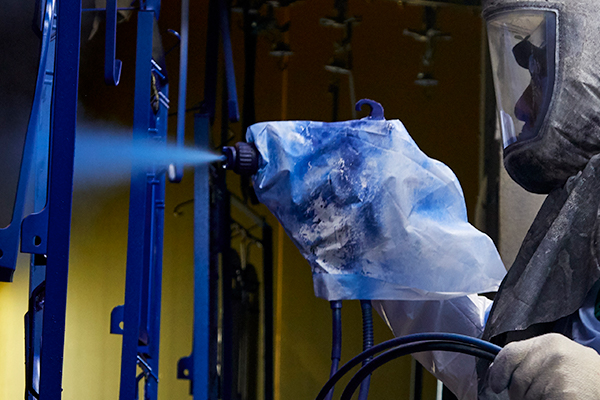How Electrostatic Spray Guns Can Benefit Your Facility
Get the full benefit of electrostatic guns by understanding what materials can be sprayed, which coatings to use and how to optimize the transfer efficiency.
How to Achieve Results with Electrostatic Spray Guns
Electrostatic guns have a number of benefits, including an excellent finish quality and a very high transfer efficiency of up to 90 percent. This high transfer efficiency rate is important because it:
- helps you save money on the cost of paint
- reduces VOCs (volatile organic compounds) and HAPs (hazardous air pollutants)
- potentially decreases permitting issues
- increases production
In order to take advantage of these benefits, it is critical that you understand what materials can be sprayed, which coatings to use and how to optimize the transfer efficiency of your manual electrostatic gun.
What materials can be sprayed with an electrostatic gun?
For starters, remember that almost anything can be sprayed with electrostatic spray guns. As long as the charged paint “sees” a conductive grounded surface, it will be attracted to it and can be painted in this manner.
Though metal is often the first material people think of, wood, plastic and rubber can also be sprayed electrostatically. Even nonconductive items can be sprayed with electrostatic spray guns, as long as they are placed between the applicator and a conductive grounded surface, or if they are sprayed conventionally first with a conductive primer.
Which coatings are correct for electrostatics?
To determine the correct coating to use with your electrostatic gun, you must consider its “resistivity”. The materials, solvents, and reducers used in the manufacture of the coatings determine the “resistivity” of the coating. This can be measured with a paint probe meter, which measures megohms per centimeter of resistance.
The best electrostatic results are achieved when the resistivity of the coating is between 25 and 50 megohms per centimeter. Getting the paint formulated from the manufacturer for electrostatic use is typically the best solution.
How to optimize the transfer efficiency
To get the full benefit of electrostatic guns there are a few items you can check.
- Proper gun setup: The proper air pressure and fluid pressure is critical for transfer efficiency. Too much air pressure will cause turbulence in the sprayed material, resulting in excessive overspray and reduced transfer efficiency. The key is to use enough air pressure to get a high quality spray pattern, but low enough to optimize transfer efficiency. Fluid pressure should be minimized to reduce bounce back of material on the substrate.
- Spray pattern height: Your spray pattern height needs to match the part you are spraying. Material blow-by from too large of a spray pattern reduces transfer efficiency. The tip size should be sized to the largest spray pattern height for your parts, but not bigger. You should also purchase a spray gun with a fan pattern adjustment knob, so as your part size varies, the operator can adjust the spray pattern height down to match the part size.
- Operator technique: How an operator uses a gun can affect transfer efficiency by 10 to 30 percent. Because of this, operators should be trained on proper spray techniques so transfer efficiency is maximized. Training should include spraying the right distance from the part, spraying perpendicular to the part, plus triggering and detriggering at the proper time.
There are also many factors in the spray booth that can impact electrostatic gun effectiveness.
- Grounding: All components in the spray booth must be properly grounded to optimize electrostatic guns. This includes the operator, the parts being sprayed, the electrostatic gun and other objects in the spray booth. Next, the spray booth and gun both need to be clean. Using gun covers and clean part hangers increases the ability of the material to be attracted to the sprayed part.
- Air conditions in the spray booth: Crossdrafts, downdrafts and high velocity air exhaust can deflect the paint away from the target, decreasing the operating efficiency of the electrostatic system. Temperature and humidity can also significantly affect the efficiency of electrostatic systems. Ideally, the booth should be an enclosed, controlled environment.
If you’re not seeing the full potential of your electrostatic system, make sure that you, or someone on your team, understands what materials can be sprayed, which coatings to use and how to optimize the transfer efficiency. Manufacturers often offer training that might be beneficial.
By following these simple steps, you should see an increase in production, a decrease in material usage, and money savings in the long run.
Related Articles
Conventional vs Electrostatic Spray Guns
Which is best for your finishing operation and budget? Seven factors can help you choose the right applicator to maximize spray performance.
Stay Grounded
When using electrostatic guns, it’s important to make sure everything within the painting system is grounded to avoid electrical hazards and increase transfer efficiency.
Electrostatic Spray Gun Basics
How do electrostatic paint spray guns work? It’s basic science.





